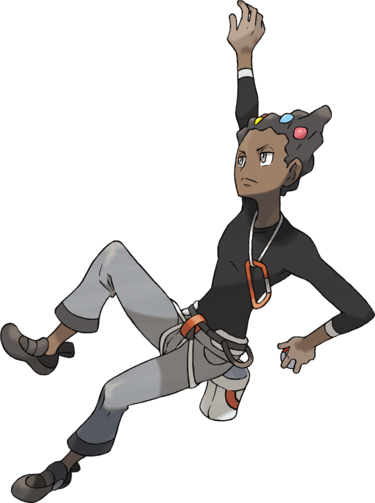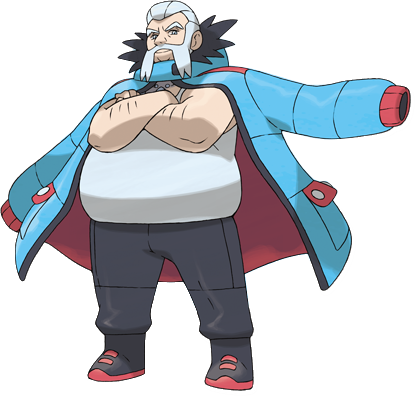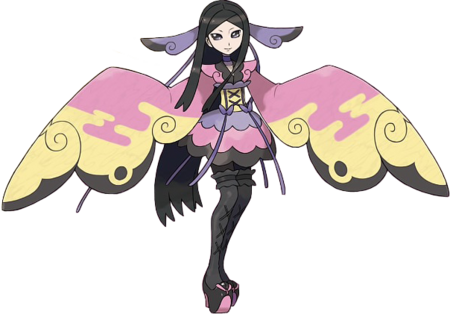#aesthetic gym leader poll
Explore tagged Tumblr posts
Text
Let's get the rules outta the way first!
All polls will be tagged "#aesthetic gym leader poll" and (appropriately numbered) "#round 1 aes gym leader poll"
The participants in this bracket are PREDETERMINED! All Gym Leaders and their direct counterparts of Trial Captains and Kahunas are involved.
REDESIGNS Do not qualify!
The ELITE 4 do not qualify. That's a different bracket to consider! Spare my small, clumsy hands more bracket work?
You VOTE FOR the Gym Leader you think is the most Aesthetic! It doesn't have to be YOUR aesthetic, but you must at least grudgingly acknowledge that they vibe deeply with an aesthetic. A deeply personal choice. Be kind. Vibe together.
Propaganda Period is from Sept 19th to Sept 24th! Send me those good, delicious propaganda! My inbox is open. It will close image submissions after the propaganda period, though their bracket images are already decided.
I have only played Ruby and watched the dub when I was a lil gal. My sibling is super into Pokemon but has a favorite so I decided to run this joint. This makes me as unbiased as possible, as I really just love the color pink.
EVEN THOUGH THE BRACKET IMAGES ARE ALREADY DETERMINED, I WILL PUT SUBMITTED CANON AESTHETIC IMAGES OF THE GYM LEADER IN THE PROPAGANDA BENEATH POLLS!
LIST OF ALL QUALIFIED POKEMON CHARACTERS (Total: 84)
Kanto: Brock, Misty, Lt. Surge, Erika, Koga, Janine, Sabrina, Blaine, Giovanni, and Blue
Johto: Falkner, Bugsy, Whitney, Morty, Chuck, Jasmine, Pryce, and Clair
Hoenn: Roxanne, Brawly, Wattson, Flannery, Norman, Winona, Tate & Liza, Wallace, and Juan
Sinnoh: Roark, Gardenia, Maylene, Crasher Wake, Fantina, Byron, Candice, and Vokner
Unova: Cilan & Chili & Cress (yes they are one gym leader), Lenora, Burgh, Elesa, Clay, Skyla, Brycen, Drayden, Iris, Cheren, Roxie, and Marlon
Kalos: Viola, Grant, Korrina, Ramos, Clemont, Valerie, Olympia, and Wulfric
Alola: Ilima, Hala, Lana, Kiawe, Mallow, Olivia, Sophocles, Acerola, Nanu, Mina, and Hapu
Galar: Milo, Nessa, Kabu, Bea, Allister, Opal, Gordie, Melony, Piers, and Raihan
Paldea: Katy, Brassius, Iono, Kofu, Larry, Ryme, Tulip, and Grusha
4 notes
·
View notes
Text


#izu does polls#pokemon#pkmn#pokemon lt surge#pokemon fantina#lt surge#gym leader fantina#pokemon rby#pokemon dp#pkmn dp#pokemon bdsp#they have such opposite aesthetics
3 notes
·
View notes
Text

hihi. here's one of my pokémon self-inserts!
(i stole the pose from an ai artist btw .)
--
i will now infodump.
i think she'll replace cleo; i never put much thought into cleo's original design + i was really depressed when i first made her, so this is a much needed retirement / redesign.
she is VERY pale. this isn't usually too big of an issue, but she's been traveling a lot + alola is frying her like an egg. is she albino? i'm not sure. probably not. she'll be safe from the sun in galar, though. i think she's definitely my palest oc and olive is probably my tannest. i'm collecting shades of white for my self inserts ig
also she has sunburns in the same pattern as her fishnets. she's very embarrassed :(
all the information i can think up for them is 1.) they are originally from sinnoh 2.) they have a raichu, 3.) they have an empoleon and 4.) they have a glaceon. idk if i want them to be a champion or gym leader or what, but she travels a lot !
if she were a gym leader, she'd go with ghost or poison to match her aesthetic, but her real favorite are electric types <3
i have two canon characters that i consider my f/os, then a handful of crushes... i'll only ship her with the two guys for now tho... if u ever guess her boyfriends no you don't <3 /j
12 notes
·
View notes
Text
OK poll time because I'm being indecisive.
Who do you think is more likely to be chat's partner pokemon? Ive already decided that his teams gonna be dark type pokemon but I just can't decide which pokemon would be his main oneee
Purrloin(or liepard) is the most obvious pick, and was my first choice, but it's too obvious tbh. Also, the purple doesn't really fit his color scheme much.
Zoroark is a good contender next to purrloin, his overall aesthetic just SCREAMS chat to me (in my au at least, which is what I'm basing this off of). He's the type of gym leader that seems intimidating at first but is really just as much of a pokemon nerd as the trainer. Dude has cat ears but his zoroark distracts people from that fact
As for Zarude... ill be honest I mostly picked him for his colors. He's literally plagg but monkey version come on. Chat has a shit ton of green in his clothes, zarude would look right at home. And much like zoroark, his vibe fits
(though I am basing all this off of gen VI and he was introduced in gen VIII but that doesn't really matter im just nitpicky..)
Anyway I'm gonna go back to drawing my son see yaaa ♡
#rambles#chat noir#ffafw rambling#mlb au#pokemon#mlb#miraculous ladybug#miraculous tales of ladybug and cat noir
5 notes
·
View notes
Text
Best Pokémon Gym Leader Tournament-
Preliminary Round-
Kalos Division: Match 1




A nice refreshing 4 contestant poll coming is in from Kalos after all those Unovan gym leaders!
Starting us off is Grant! Rock climber, fossil user, and all round cool guy- he's going up against Korrina! The very first battle any of us got to use mega-evolution in was against this fiery fighter! Her Lucario may not have been in her gym battle, but they've left an impact just like her skating rink gym puzzle. Also in the mix is Wulfric, the stalwart Ice user. (Whose head is getting cut off because of tumblr handling images weirdly- sorry Wulfric!) He's a tough guy with the 'stache to prove it- and stands as a challenge between all Kalos trainers and the elite four. He also challenges Valerie! The first ever Fairy type user, with a fairy tail aesthetic and a Sylveon by her side, can she take the top spot in this Preliminary match?
Remember- the top two competitors will move on to round 1, not just the winner!
25 notes
·
View notes
Text


Enki, your rock-type gym leader for the Pokemon Trainer AU
I would have had him drawn far earlier on if I'd been more confident.
Enki has two loves: fossil pokemon, and being able to show people how cool revived fossil pokemon are. Oh, and history and archaeology, he supposes. Nacrene City's resident eccentric rock expert rightly also has an abundance of knowledge about the Unova region, and is willing to tell anyone whatever they may want to know in much more detail than they might care for. It's believed he tries to impart on trainers the knowledge that, if trained correctly, any pokemon has the ability to be powerful in their own rights... at least, that's what people assume he's trying to get accros.
Enki is a native Unovan but also has heritage from Paldea and Alola. If you see him in the Nacrene City Museum and he's not showing everyone his archeops, it's not uncommon to find him explaining history to young children.
His team consists of:
Sealie (Cradily, female, Impish nature)
Selen (Lunatone, Relaxed nature)
Helio (Solrock, Serious nature)
Ignus (Crustle, male, Mild nature)
Ateria (Archeops, female, Sassy nature)
Quartz (Gigalith, female, Jolly nature)
Some additional fun facts:
-There are several characters that can be his trainer basis, but the most notable ones are Gym Leader Lenora and the Fossil Maniac trainer class. His outfit is both a rough estimate of what I figure an archaeology-core aesthetic outfit would look like as well as Rick O'Connell from The Mummy.
-In case the name doesn't give it away: Enki is supposed to be Inka-Dinka-Doo from the DKC cartoon. His name here is derived from Enkidu, a figure of legend in The Epic of Gilgamesh, who from my research is one of his name inspirations for the show as well. (I could be wrong; feel free to correct me if I am.)
-Enki was almost part of the Elite 4, fitting into the theme of it due to how many of the mishaps in the cartoon could have been avoided if Inka had just explained himself. I couldn't decide for myself who of the two characters it should have been, so the final member was chosen through Twitter poll by their typing. Rock lost.
-Unlike a few other characters I have and will be introducing at some point, I actually have had a rough non-statue form for Inka since the dawn of time pretty much. All I really did between his current gijinka design and this one other than the clothes is shorten his hair.
-Although history and fossils are his chief loves, he's also quite fond of board games and has a massive collection of them. His favorite is a copy of the very first edition of Trivial Pursuit.
-Someone once brought an oddly-shapped rock into the museum to see what kind it was as they were having trouble identifying it. Enki took it, licked it, and properly identified it as a fragment of a Rare Bone.
-He and Skurvy once fist-fought in a fast food restaurant's parking lot at 2 am over whether rock-types or water-types were better. It ended in a draw. They didn't even order anything.
#inka-dinka-doo#donkey kong country#donkey kong#gijinka#pokemon trainer au#dkc pokemon trainer au#mun arts#real talk the alt art is one of my faves. look how happy he is#also i almost wrote ''when he's not showing everyone his cradily'' but it sounded SUPER sus
2 notes
·
View notes
Note
Also requesting my favourite pokemon, Lucario!

Oh DANG, it’s Lucario!!!!!!
Lucario’s HUGE. Literally the second-most-beloved pokemon in the franchise according to the Pokemon of the Year poll, Lucario represents a perfect storm of factors all coming together to result in an ASTOUNDING degree of popularity. It’s…..rly big. For comparison, Pikachu got 19th in that same poll.

It all started with a movie, Lucario and the Mystery of Mew, released about a year before Gen IV’s Diamond and Pearl did, with Lucario being one of the first looks at the upcoming generation. Because Pokemon movies up to this point had featured legendaries, people had assumed Lucario, too, was a legendary, and the movie did little to disconfirm this. It could talk, it had a unique anthropomorphic design unlike most other pokemon seen thus far, and it had special powers that seemed unaffiliated with any particular type, dubbed “aura”. Already a recipe for hype!

Once Gen IV came out, it became apparent that Lucario was actually just a normal pokemon, a Fighting/Steel-type (for….some reason), even having a pre-evolution in Riolu. But it still felt special: neither it nor Riolu could be found in the wild, with a Riolu egg instead being obtained through an optional sidequest trekking through a cave on Iron Island. You would be accompanied by someone named Riley, whose design harkened to a movie character named Sir Aaron, and who himself used a Lucario. As a reward for your help, he would bestow you with an egg, that would then hatch into Riolu and you could then evolve into Lucario after raising its friendship level.

Lucario’s popularity was practically sealed. It had a massive amount of marketing through the movie and other media that built up to DP’s eventual release, and when DP finally did come out, Lucario had a perfect balance of difficulty to obtain it with how likely a player was to actually encounter it. It just felt SPECIAL, in a way no other pokemon ever quite has, before or since.

As a design, I respect Lucario. It’s certainly got some peculiar quirks to it: the anime mouth doesn’t sit right on the face with respect to the snout, the oddly-bent tail feels kinda haphazardly glued on, the aesthetic of wearing parachute shorts is kinda weird, and the only allusion to it being Steel-type seems to be its rather nonsensical spikes. But an anthropomorphic blue jackal with a clear Anubis-inspired silhouette is undeniably cool, and I feel positively toward it overall despite some odd decisions. And I actually like the dreads!

Naturally, it would later be a recipient of a Mega Evolution in XY, and a pretty alright one overall. However, one result of its popularity led to it missing part of what made it so popular in the first place: all players would receive one from a gym leader as a natural part of XY’s story. Appropriate for such an iconic pokemon to introduce Mega Evolution, sure, but it made it apparent how much of that “special” aspect Lucario had since lost. Being gifted one for free just didn’t hit right. As a design, Mega Lucario’s red markings feel a bit excessive, and I’m not as into it as I am the base design. It’s not bad, though, and the floofy tail’s an improvement.

Lucario’s shiny swaps the blue and yellow, albeit with the yellow now a more unnatural citrus tone. Suitably distinct from the base form, but not really an improvement. Mega Lucario keeps the general colour scheme, but shifted darker into a rather unpleasant olive shade.
Overall, I like Lucario. It’s got some weird aesthetic choices, but on the whole it’s pretty neat and VERY iconic. I don’t particularly vibe with it myself these days, but I definitely understand those who do, and I find its immense popularity both justified and unsurprising.
Also same Eng VA as Goku/10.
#pokemon#pokemon reviews#swsh#pkmn#lucario#mega lucario#riolu#fighting-type#steel-type#sinnoh#gen 4#stormmodblog
30 notes
·
View notes
Text
The Digital Fitness Boom Is Closing Gender Gaps in Health and Wellness – Healthline

Fitness apps like Sweat and FiiT are proving to be unlikely solutions to the disproportionate burden women felt through the pandemic, as well as the gaps in gender equity that have always plagued fitness.
The gender gap in physical activity is something researchers have studied for years. Women are often less likely to be physically active due to gender roles and responsibilities that command how they spend their free time (1).
During the COVID-19 pandemic, that gender gap in physical activity only intensified (2, 3).
As the pandemic wore on and digital fitness options became more readily available, both men and women began to participate more in physical activities. Yet, the rate at which women participate in these activities still lags far behind that of men (3).
According to a recent poll, more than half of women (55%) reported that the COVID-19 pandemic negatively affected their mental health, compared with about 4 in 10 men (38%) (4).
We know that physical activity improves mental health and cognitive function among adults and reduces the risk of depression among children (5).
As such, addressing the gender gap in fitness is key to recovering from the stress of living through a pandemic. Doing so ultimately gives us reason to be optimistic about how we might push forward toward an even greater collective well-being.
As gym doors closed and fitness companies began moving their classes and coaching to online platforms, digital fitness took off.
Soon it was clear: The digital fitness boom can not only empower women to close the gender gap in physical activity but also ease the pandemic’s disproportionate mental and physical burden on them.
According to fitness app Strava’s Year in Sport report, between April and September 2020, women ages 18–29 tracked 45.2% more fitness activities than they did during the same period last year, compared with a 27.3% increase among their male counterparts (6).
Women are exercising more overall, but still not as much as men. Nevertheless, there are signs that the recent boom in digital fitness could close the gaps in accessibility and inclusivity for many people who, before now, either couldn’t work out at a gym or didn’t feel welcome, including women.
If we embrace and support digital fitness communities, we’ll continue to break through obstacles to women’s accessibility to physical activity. The barriers we’ll power through are reflective of long-standing challenges.
Economic barriers
Costs associated with physical activity, such as purchasing equipment and gym membership fees, are notable barriers to physical activity.
According to the World Health Organization (WHO), the costs are a more substantial barrier for women because their income is often lower than that of men (7).
Such costs are especially high expenditures for single mothers, which is one reason single mothers often report substantial barriers to physical activity (8).
While digital fitness can also be quite costly (for example, at the time of publication, the Mirror costs $1,495 plus a $39 per month access subscription), numerous affordable and even free exercise classes and apps only require participants to bring their bodies.
A 2019 Report from the Global Wellness Institute attributes a significant portion of the worldwide growth in the practice of yoga to its online availability, which lowers cost barriers to participation (9).
With 77% of US women having a broadband connection at home and an additional 15% having access to the internet through their smartphones, the pandemic-induced increase in the availability of low cost or free digital fitness programs provides hope for addressing economic barriers to physical activity (10).
Time barriers
Reports frequently point out women’s domestic workloads and roles as caregivers as factors that limit their time to participate in physical activity or get to the gym.
The pandemic reinforced this barrier, with a 2020 Deloitte study observing that the number of women reporting responsibility for 75% or more of caregiving duties has nearly tripled to 48% during the pandemic (11).
Digital fitness communities provide a practical outlet for women to engage in physical activity on their own terms and in their own space, both physically and emotionally (12).
The ease of connecting to a livestream class from home with their dependents close by, or of streaming an on-demand video of a convenient duration any time of the day or night, makes fitting in time to exercise easier than ever for many women.
Cultural barriers
When it comes to sports participation, cultural norms, aesthetic pressure, and expectations around gender create a fear of being judged among women (12).
In one study on gender differences in strength training, women cite the presence and behaviors of men, feeling like they don’t know how to properly use the equipment, and feeling self-consciousness as common reasons for avoiding weight rooms and equipment (13).
Digital fitness communities provide a safe, private space with social support — something typically lacking for women in many male-dominated sport environments. The social encouragement, inspiration, and accountability inherent in women-focused digital fitness communities are promising steps forward in addressing cultural barriers to physical activity.
The global fitness industry is experiencing a digital revolution. As a result, a growing number of options are available for those who want to try various types of exercise — whether it’s a live-streamed yoga class with a $20 mat or an indoor mountain climb on a $2,495 Peloton bike.
Digital fitness is here to stay, even after the pandemic, and it can only help tackle the gender gap that has kept women from fully experiencing the benefits of physical activity. The digital fitness boom is empowering women both physically and mentally — and this year, we’ve more than earned the right to invest in ourselves.
This piece was crafted in partnership with The Collective Think Tank, a global consortium of academic minds and industry leaders focused on gender parity and improving diversity. The collaboration is led by The Collective, the international marketing agency Wasserman’s women-focused division.
Mujde Yuksel, PhD, is an Associate Professor of Marketing at Suffolk University. She is a consumer behavior researcher with special interests in digital consumption and sports and entertainment marketing. Prior to academia, she had a 10-year background in professional sports as a basketball player for the Turkish National Team and prominent sports organizations in Turkey.
source https://wealthch.com/the-digital-fitness-boom-is-closing-gender-gaps-in-health-and-wellness-healthline/
0 notes
Text
Catholic Church #1 Review
One thing I did not realize is growing up is that the Catholic Church tries to be very opulent. Especially compared to other religious buildings, it seems as if every Catholic Church goes out of their way to look like the freaking Pope lives there. The one I participated in was no different. Marble floors, beautifully detailed stained glass windows, a marble fountain that spouted holy water.
So walking in, it was very pretty. and VERY packed. I came a bit late so I had to stand in the back. Clearly Catholicism is pretty big in the United States.
I wonder how Catholic services were first organized? Who determined how things would run, typically? The service seemed to be exactly how I remembered it as a child. First some song and a prayer, then the priest tells a story, then more songs and prayer while they collect money, some bible verses, some more songs, a lot of prep work for communion, people kneel and shake hands, then communion, then another short prayer and then everybody goes home.
Do priests get tired of this? The same thing, every single time. I wonder what the alter boys think. Are they that devout that they don’t mind the slog, or do their parents make them do this? They seem too young to be this dedicated to the cause. Instilling a religion into a child always seemed to be borderline abuse to me. There’s a fine line between naturally presenting your child with all of your ideological viewpoints, and forcing your child to participate in a religion to a certain level of devotion. Sometimes people feel bad for kids born to parents in cults because of the weird rituals and beliefs that they grew up performing. One good thing about Catholic Church services: you know what you’re getting. They’re very comfort-food like. All you have to do is go and listen and follow instructions.
But I did find the services to be very cult-like. From the moment you walk in and have to bless yourself (make the sign of the cross) with holy water, to the moment you walk out and…do the same thing. It’s such a weird phenomena. Do these worshipers do this simply out of tradition, or do they believe in some sort of power that this water can bring them? Do they do it so they won’t go to hell? Will I go to hell because I did the water thing but I don’t believe in their god?
I love the kneeling thing the most because I find it to be the most cynical thing. It seems very subservient to me. I understand the desire to do this if you believe in a higher power and want to submit yourself to him (or her! or it), however my values and beliefs lie so far away from this need to submit to a higher power that it comes across and degrading. Can people not find happiness and meaning without religious dogma? Likewise the priest is not the best story-teller, which I think you have to be if you’re going to be a priest. His story was amicable, from what I heard of it. He spoke kind of low and I was in the back, so it was difficult to hear him. It was your typical sermon from my point of view. He was telling a story about how sacrificing for others is a good thing and can help you become a good person, and also Jesus. The Jesus and religion bits seemed really ham-fisted in this story, but ultimately it was a good message.
The priest also mentioned something about life on Earth compared to the eternal bliss of the afterlife. I really hate this line of thinking, because again it degrades the sanctity of life (in my opinion). I feel having this much confidence in the idea that your short 60-80 years is just the first phase of an even longer, better, fitter, happier, Not drinking too much, Regular exercise at the gym, three days a week, Getting on better with your associate employee contemporaries, At ease, life eternal is a bad coping mechanism for the fear of non-existence. This ideology at best provides misguided motivation to lead a good life, and at worst can lead to the religious extremism that can negatively impact those who are not as devout. I get that the idea is a pleasing one, but I would rather have a harsh truth than a comforting lie….generally. Especially for the big things in life. Not only is the idea of an afterlife bad logic, but belief in it can have negative consequences.
My favorite part of Catholic mass? The money collection. Whoever came up with the way to integrate fund collection IN the religious service itself is most likely in hell, but was probably Sainted here on Earth. I always assumed Jesus was not really the type of guy who cared much for money, but Catholics need their $$$ to be able to upkeep their opulent collection agencies! Truly a genius idea. No other religion, as far as I know (not that I know much) has a designated donation segment as part of their religious services. As smart of an idea as it is from a business perspective, I feel it certainly detracts from the spiritual journey one is supposed to be on. It may also provide a poor lesson to the young and easily influenced: prayer services and money collection SHOULD go together. I would argue the opposite.
The whole event seemed like a very carefully orchestrated ballet, where priests, alter boys, and worshipers all did certain things at certain times. However ballets are typically choreographed for some sort of aesthetically pleasing reason or because it would move the plot along. Why are Catholic masses run this way? Will I become closer to God by watching the priest perform certain movements in certain ways? Finally: Communion. The big dog. It seemed like the final 20 minutes were dedicated to this, between the preparation, actually going through it, and the epilogue. I did not realize how big of a deal this is to every single mass. Again, it must get really boring for the priests. I wonder what it would be like for a person who is not used to Catholicism to go through this. I was very weirded out at both the Mosque and the Buddhist Temple because those were cultures I was not used to. But I know Catholic mass. This was weird to be me because I view all religions as cults which serve no purpose other than to provide a sense of security to people who have not found it without religious dogma, but I have to imagine if I were not used to Catholic mass I would freak out at this part. Everyone lines up to eat a cracker that is metaphorically a piece of the body of Jesus. Which part? His whole body? Did Jesus work out, would he taste good? Why are we drinking his blood? It seems as if Catholics would get along with Vampires, even though Catholic symbolism helps keep them at bay. I thought the cracker tasted good, I wonder how many calories are in that thing. Do they make chocolate flavored Jesus Body? Can we substitute wine with pomegranate juice?
Going to a Catholic mass again just made me want to become a religious leader. Not sure which religion, but I would love to get paid to spout a religion at people.
Then when everybody leaves, they all go to the holy water fountain. What makes this water holy? Who blessed it? Can I put a curse on it to make it unholy? Why does everybody do this? Such a weird thing to do. I wanted to take a poll about who was doing it because it is just “what you do” versus who was doing it because they found a deeper meaning to it as a part of the entire religious service.
0 notes
Link

Fitness apps like Sweat and FiiT are proving to be unlikely solutions to the disproportionate burden women felt through the pandemic, as well as the gaps in gender equity that have always plagued fitness.
The gender gap in physical activity is something researchers have studied for years. Women are often less likely to be physically active due to gender roles and responsibilities that command how they spend their free time (1).
During the COVID-19 pandemic, that gender gap in physical activity only intensified (2, 3).
As the pandemic wore on and digital fitness options became more readily available, both men and women began to participate more in physical activities. Yet, the rate at which women participate in these activities still lags far behind that of men (3).
According to a recent poll, more than half of women (55%) reported that the COVID-19 pandemic negatively affected their mental health, compared with about 4 in 10 men (38%) (4).
We know that physical activity improves mental health and cognitive function among adults and reduces the risk of depression among children (5).
As such, addressing the gender gap in fitness is key to recovering from the stress of living through a pandemic. Doing so ultimately gives us reason to be optimistic about how we might push forward toward an even greater collective well-being.
As gym doors closed and fitness companies began moving their classes and coaching to online platforms, digital fitness took off.
Soon it was clear: The digital fitness boom can not only empower women to close the gender gap in physical activity but also ease the pandemic’s disproportionate mental and physical burden on them.
According to fitness app Strava’s Year in Sport report, between April and September 2020, women ages 18–29 tracked 45.2% more fitness activities than they did during the same period last year, compared with a 27.3% increase among their male counterparts (6).
Women are exercising more overall, but still not as much as men. Nevertheless, there are signs that the recent boom in digital fitness could close the gaps in accessibility and inclusivity for many people who, before now, either couldn’t work out at a gym or didn’t feel welcome, including women.
If we embrace and support digital fitness communities, we’ll continue to break through obstacles to women’s accessibility to physical activity. The barriers we’ll power through are reflective of long-standing challenges.
Economic barriers
Costs associated with physical activity, such as purchasing equipment and gym membership fees, are notable barriers to physical activity.
According to the World Health Organization (WHO), the costs are a more substantial barrier for women because their income is often lower than that of men (7).
Such costs are especially high expenditures for single mothers, which is one reason single mothers often report substantial barriers to physical activity (8).
While digital fitness can also be quite costly (for example, at the time of publication, the Mirror costs $1,495 plus a $39 per month access subscription), numerous affordable and even free exercise classes and apps only require participants to bring their bodies.
A 2019 Report from the Global Wellness Institute attributes a significant portion of the worldwide growth in the practice of yoga to its online availability, which lowers cost barriers to participation (9).
With 77% of US women having a broadband connection at home and an additional 15% having access to the internet through their smartphones, the pandemic-induced increase in the availability of low cost or free digital fitness programs provides hope for addressing economic barriers to physical activity (10).
Time barriers
Reports frequently point out women’s domestic workloads and roles as caregivers as factors that limit their time to participate in physical activity or get to the gym.
The pandemic reinforced this barrier, with a 2020 Deloitte study observing that the number of women reporting responsibility for 75% or more of caregiving duties has nearly tripled to 48% during the pandemic (11).
Digital fitness communities provide a practical outlet for women to engage in physical activity on their own terms and in their own space, both physically and emotionally (12).
The ease of connecting to a livestream class from home with their dependents close by, or of streaming an on-demand video of a convenient duration any time of the day or night, makes fitting in time to exercise easier than ever for many women.
Cultural barriers
When it comes to sports participation, cultural norms, aesthetic pressure, and expectations around gender create a fear of being judged among women (12).
In one study on gender differences in strength training, women cite the presence and behaviors of men, feeling like they don’t know how to properly use the equipment, and feeling self-consciousness as common reasons for avoiding weight rooms and equipment (13).
Digital fitness communities provide a safe, private space with social support — something typically lacking for women in many male-dominated sport environments. The social encouragement, inspiration, and accountability inherent in women-focused digital fitness communities are promising steps forward in addressing cultural barriers to physical activity.
The global fitness industry is experiencing a digital revolution. As a result, a growing number of options are available for those who want to try various types of exercise — whether it’s a live-streamed yoga class with a $20 mat or an indoor mountain climb on a $2,495 Peloton bike.
Digital fitness is here to stay, even after the pandemic, and it can only help tackle the gender gap that has kept women from fully experiencing the benefits of physical activity. The digital fitness boom is empowering women both physically and mentally — and this year, we’ve more than earned the right to invest in ourselves.
This piece was crafted in partnership with The Collective Think Tank, a global consortium of academic minds and industry leaders focused on gender parity and improving diversity. The collaboration is led by The Collective, the international marketing agency Wasserman’s women-focused division.
Mujde Yuksel, PhD, is an Associate Professor of Marketing at Suffolk University. She is a consumer behavior researcher with special interests in digital consumption and sports and entertainment marketing. Prior to academia, she had a 10-year background in professional sports as a basketball player for the Turkish National Team and prominent sports organizations in Turkey.
via Wealth Health
0 notes